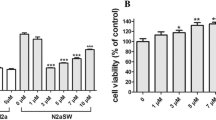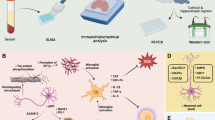Abstract
Amyloid beta (Aβ) is the main component of the amyloid plaques that accumulate in the brains of Alzheimer patients. The present study was conducted to investigate whether the combined treatment with selenium (Se) and zinc (Zn) offers more beneficial effects than that provided by either of them alone in reversing Aβ25–35-induced neurotoxicity in PC12 cells. Cells were pretreated with 0.1 μmol/L of Se and Zn for 4 h, after treated with 10 mmol/L Aβ25–35 for 24 h. Cells were divided into control and five treated groups, and received either 10 mmol/L Aβ25–35,10 mmol/L Aβ25–35 + 0.1 μmol/L Se, 10 mmol/L Aβ25–35 + 0.1 μmol/L Zn, 10 mmol/LAβ25–35 + 0.1 μmol/L Se + 0.1 μmol/L Zn, or 0.1 μmol/L Se + 0.1 μmol/L Zn. The result showed that cell viability was decreased in MTT metabolic rate; LDH release and MDA, H2O2, and NO levels were increased and the GSK-3β and phosphorylated tau protein level were increased in Aβ25–35-treated group (P < 0.05 or P < 0.01), which whole changes were attenuated by Se and Zn and Se combined Zn. In order to evaluate whether the Se and Zn have an effect on processing pathway of amyloid precursor protein (APP), we examined the activity of γ-secretase in primary cultured cortical neuron cells. ELISA analysis showed that Se and Zn could inhibit the activity of γ-secretase. Then we also investigated the effect of Se and Zn on the Aβ1–40 concentration and APP-N-terminal fragment expression from APP695 stably transfected Chinese hamster ovary (CHO) cells. APP695 stably transfected CHO cells were treated with 0.1 μmol/L Se and Zn; cells were divided into control and four treated groups, which received either 0.5 M DAPT, 0.1 μmol/L Se, 0.1 μmol/L Zn, or 0.1 μmol/L Se + 0.1 μmol/L Zn. Se and Zn could decrease Aβ1–40 production and increase the APP-N-terminal fragment protein expression. These experiments indicate that Se and Zn have a protective effect on AD pathology that a possible mechanism is inhibiting the activity of γ-secretase to decreasing Aβ1–40 production further influencing the APP processing. Altogether, our findings may provide a novel therapeutic target to treat AD sufferers.





Similar content being viewed by others
References
Yankner BA (1996) New clues to Alzheimer’s disease: unraveling the roles of amyloid and tau. Nat Med 2:850–852
Yankner BA, Duffy LK, Kirschner DA (1990) Kirschner Neurotrophic and neurotoxic effects of amyloid β protein: reversal by tachykinin neuropeptides. Science 250:279–282
Varadarajan S, Kanski J, Aksenova M (2001) Different mechanisms of oxidative stress and neurotoxicity for Alzheimer’s A beta(1–42) and A beta(25–35). J Am Chem Soc 123:5625–5631
De Strooper B, Annaert W (2000) Proteolytic processing and cell biological functions of the amyloid precursor protein. J Cell Sci 113:1857–1870
Crump CJ, Johnson DS, Li YM (2013) Development and mechanism of γ-secretase modulators for Alzheimer’s disease. Biochemistry 52(19):3197–3216
Aaseth J, Alexander J, Bjørklund G, Hestad K, Dusek P, Roos PM, Alehagen U (2016) Treatment strategies in Alzheimer’s disease: a review with focus on selenium supplementation. Biometals 29:827–839
Gerber H, Wu F, Dimitrov M, Garcia Osuna GM, Fraering PC (2017) Zinc and copper differentially modulate amyloid precursor protein processing by γ-secretase and amyloid-β peptide production. J Biol Chem 292(9):3751–3767
Zheng R, Zhang ZH, Chen C, Chen Y, Jia SZ, Liu Q, Ni JZ, Song GL (2017) Selenomethionine promoted hippocampal neurogenesis via the PI3K-Akt-GSK3β-Wnt pathway in a mouse model of Alzheimer’s disease. Biochem Biophys Res Commun 17:30103–30101
Zhang ZH, Wu QY, Zheng R, Chen C, Chen Y, Liu Q, Hoffmann PR, Ni JZ, Song GL (2017) Selenomethionine mitigates cognitive decline by targeting both tau hyperphosphorylation and autophagic clearance in an Alzheimer’s disease mouse model. J Neurosci 37(9):2449–2462
Zheng L, Zhu HZ, Wang BT, Zhao QH, Du XB, Zheng Y, Jiang L, Ni JZ, Zhang Y, Liu Q (2016) Sodium selenate regulates the brain ionome in a transgenic mouse model of Alzheimer’s disease. Sci Rep 6:39290
Rao SV, Prakash B, Raju MV, Panda AK, Kumari RK, Reddy EP (2016) Effect of supplementing organic forms of zinc, selenium and chromium on performance, anti-oxidant and immune responses in broiler chicken reared in tropical summer. Biol Trace Elem Res 172(2):511–520
Xu YJ (2011) Effect of selenium and zinc on deficit of learning and memory and the levels of MDA & NO in dementia mice model. J Nutr (China J) 33(2):118–120
Yan SD, Chen X, Fu J, Chen M, Zhu H, Roher A, Slattery T, Zhao L, Nagashima M, Morser J, Migheli A, Nawroth P, Stern D, Schmidt AM (1997) RAGE andamyloid-beta peptide neurotoxicity in Alzheimer’s disease. Nature 382:685–691
Haass C, Selkoe D (1994) Cellular processing of beta-amyloid precursor protein and the genesis of amyloid beta-peptide. Cell 7:1039–1042
Pike CJ, Walencewicz AJ, Glabe CG, Cotman CW (1991) In vitro aging of betaamyloidprotein causes peptide aggregation and neurotoxicity. Brain Res 563:311–314
Lorenzo A, Yankner BA (1996) Amyloid fibril toxicity in Alzheimer’s disease and diabetes. Ann N Y Acad Sci 777:89–95
Tohda C, Tamura T, Matsuyama S, Komatsu K (2006) Promotion of axonal maturation and prevention of memory loss in mice by extracts of Astragalus mongholicus. Br J Pharmacol 149:532–541
Song G (2014) Selenomethionine ameliorates cognitive decline, reduces tau hyperphosphorylation, and reverses synaptic deficit in the triple transgenic mouse model of Alzheimer’s disease. J Alzheimers Dis 41:85–99
Hubin E, van Nuland NA, Broersen K (2014) Transient dynamics of Abeta contribute to toxicity in Alzheimer’s disease. Cell Mol Life Sci 71:3507–3521
Durand D, Carniglia L, Beauquis J (2014) Astroglial mGlu3 receptors promote alpha-secretase-mediated amyloid precursor protein cleavage. Neuropharmacology 79:180–189
Majzoub A, Agarwal A (2017) Antioxidant therapy in idiopathic oligoasthenoteratozoospermia. Indian J Urol 33(3):207–214
Gromova OA, Torshin IY, Pronin AV, Kilchevsky MA (2017) Synergistic application of zinc and vitamin C to support memory, attention and the reduction of the risk of the neurological diseases. Zh Nevrol Psikhiatr Im S S Korsakova 117(7):112–119
Rükgauer M, Neugebauer RJ, Plecko T (2001) The relation between selenium, zinc and copper concentration and the trace element dependent antioxidative status. J Trace Elem Med Biol 15:73–78
El-Sharaky AS, Newairy AA, Badreldeen MM, Eweda SM, Sheweita SA (2007) Protective role of selenium against renal toxicity induced by cadmium in rats. Toxicology 235:185–193
Newairy AA, El-Sharaky AS, Badreldeen MM, Eweda SM, Sheweita SA (2007) The hepatoprotective effects of selenium against cadmium toxicity in rats. Toxicology 242:23–30
Rapoport M, Dawson HN, Binder LI, Vitek MP, Ferreira A (2002) Tau is essential to beta-amyloid-induced neurotoxicity. Proc Natl Acad Sci U S A 99:6364–6369
Busciglio J, Lorenzo A, Yeh J, Yankner BA (1995) Beta-amyloid fibrils induce tau phosphorylation and loss of microtubule binding. Neuron 14:879–888
Greenberg SM, Qiu WQ, Selkoe DJ, Ben-Itzhak A, Kosik KS (1995) Aminoterminal region of beta-amyloid precursor protein activates mitogen activated protein kinase. Neurosci Lett 198:52–56
Takashima A, Honda T, Yasutake K, Michel G, Murayama M, Murayama O, Ishiguro K, Yamaguchi H (1998) Activation of tau protein kinase I/glycogensynthase kinase-3beta by amyloid beta peptide (25–35) enhances phosphorylation of tau in hippocampal neurons. Neurosci Res 31:317–323
Rapoport M, Ferreira A (2000) PD98059 prevents neurite degeneration induced by fibrillar beta-amyloid in mature hippocampal neurons. J Neurochem 74:125–133
Zheng WH, Bastianetto S, Mennicken F, Ma W, Kar S (2002) Amyloid beta peptide induces tau phosphorylation and loss of cholinergic neurons in rat primary septal cultures. J Neurosci 115:201–211
Rank KB, Pauley AM, Bhattacharya K, Wang Z, Evans DB, Fleck T, Johnston JA, Sharma SK (2002) Direct interaction of soluble human recombinant Abeta1-42 results in tau aggregation und hyperphosphorylation by tau protein kinase II. FEBS Lett 514:263–268
Leschik J, Welzel A, Weissmann C, Eckert A, Brandt R (2007) Inverse and distinct modulation of tau-dependent neurodegeneration by presenilin 1 and amyloid-b in cultured cortical neurons: evidence that tau phosphorylation is the limiting factor in amyloid-b-induced cell death. J Neurochem 101:1303–1315
Jacobs KM, Bhave SR, Ferraro DJ, Jaboin JJ, Hallahan DE, Thotala D (2012) GSK-3β: a bifunctional role in cell death pathways. Int J Cell Biol 2012:930710
Pei JJ, Braak E, Braak H, Grunde-Iqbal I, Iqbal K, Winblad B et al (1998) Distribution of active glycogen synthase kinase 3 beta(GSK-3 beta) in brains staged for Alzheimer disease neurofibrillary changes. J Neuropathol Exp Neurol 58:1010–1019
Messaoudi I, El Heni J, Hammouda F, Saïd K, Kerkeni A (2009) Protective effects of selenium, zinc, or their combination on cadmium-induced oxidative stress in rat kidney. Biol Trace Elem Res 130:152–161
Faure P, Barclay D, Joyeux-Faure M, Halimi S (2007) Comparison of the effects of zinc alone and zinc associated with selenium and vitamin E on insulin sensitivity and oxidative stress in high-fructose-fed rats. J Trace Elem Med Biol 21:113–119
Acknowledgements
This work was financially supported by the Research Fund of Jilin Provincial Education Department (2016-279) and the National Science Foundation of China (81160159) and China Scholarship Council (2016-3192).
Author information
Authors and Affiliations
Corresponding author
Rights and permissions
About this article
Cite this article
Li, Gz., Liu, F., Xu, C. et al. Selenium and Zinc against Aβ25–35-Induced Cytotoxicity and Tau Phosphorylation in PC12 Cells and Inhibits γ-cleavage of APP. Biol Trace Elem Res 184, 442–449 (2018). https://doi.org/10.1007/s12011-017-1162-4
Received:
Accepted:
Published:
Issue Date:
DOI: https://doi.org/10.1007/s12011-017-1162-4




